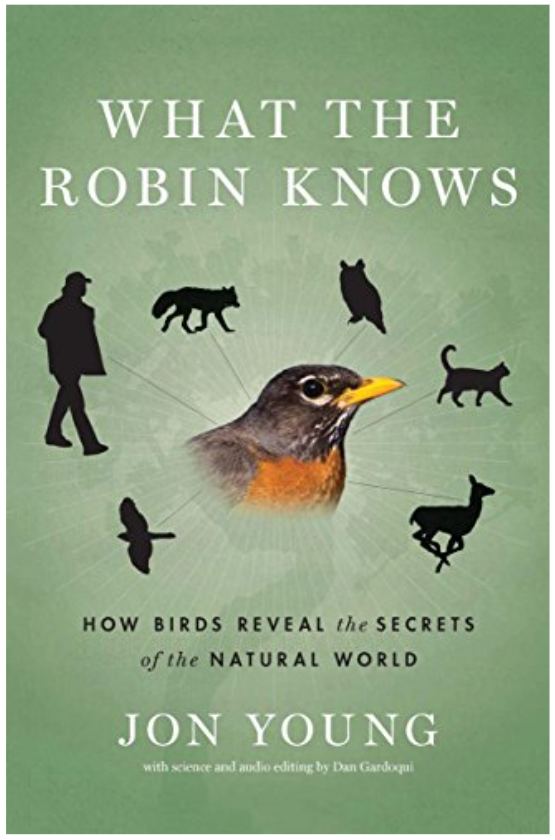My new retirement hobby is learning to understand the LANGUAGE that the birds are speaking! I was pleased to find a well written, popular book on this very topic. If you get the electronic edition, then you can actually hear sound clips of the various bird calls that he is describing while you read it. This will help you further enjoy being in the woods and seeing more wildlife, beyond just birds.
Many of the sounds that we associate with birds are actually their “alarm calls”, alerting other birds and animals about a human walking nearby… If you take the time to read this book, you will begin be able to add 4th dimension to your walks in the woods, which lets you understand the meaning of the various types of alarm calls, from various types of birds, which effectively gives you a viewing radius of what’s going on all around you for more than a kilometer. That new insight will enable you to “see” lots of other non-bird wildlife that you otherwise would not have the opportunity to see. The techniques explained originate from indigenous peoples insights.
The animals in the woods listen to the bird sounds, and use them as a first alert notifications of possible risks, or even possible food sources. So when you understand what the birds are saying and apply the knowledge appropriately, you will see more wildlife – and even avoid being threatened by wildlife.
Five basic Vocalization types
As you become familiar with the bird sounds, you will find that they are actually split into five categories. Understanding them is helpful.
- Songs
- Companion calls
- Territorial aggression
- Adolescent begging
- Alarms
Your phone can help identify birds by their SOUND !
Using a phone app you can “see” the chirping birds that are near you as you walk. The “Merlin Bird ID” app has an amazing “Sound ID” mode, where it hears a bird sound, and helps you identify what it is. Then you can playback samples to compare and affirm its artificial intelligence (AI) accuracy. The free app is produced by The Cornell Lab of Cornell University (Click here to read more on their site)
During my 15 minute walk in an urban park near where we live, I was shocked to see so many vibrant colored birds living in the woods. Now I have started to use my eyes to follow the sound. The grey block at the top is a graphical representation of the sound spectrum that has been heard and recorded. It helps you rewind to the peaks where there is a bird sound. It also DYNAMICALLY highlights the bird name in yellow, when it hears a subsequent encounter.

The app is actually like a bird guide book, plus has visual identification aids too..
What the Robin Knows: How Birds Reveal the Secrets of the Natural World, by Jon Young.
Amazon writeup:
A guide to listening to songbirds—the key to observing nature in a whole new way. Includes audio of bird vocalizations!
A lifelong birder, tracker, and naturalist, Jon Young is guided in his work and teaching by three basic premises: the robin, junco, and other songbirds know everything important about their environment, be it backyard or forest; by tuning in to their vocalizations and behavior, we can acquire much of this wisdom for our own pleasure and benefit; and the birds’ companion calls and warning alarms are just as important as their songs.
Birds are the sentries of—and our key to understanding the world beyond our front door. By learning to remain quiet and avoid disturbing the environment, we can heed the birds and acquire an amazing new level of awareness. We are welcome in their habitat. The birds don’t fly away. The larger animals don’t race off. No longer hapless intruders, we now find, see, and engage the deer, the fox, the red-shouldered hawk—even the elusive, whispering wren.
Deep bird language is an ancient discipline, perfected by Native peoples the world over. Finally, science is catching up. This groundbreaking book unites the indigenous knowledge, the latest research, and the author’s own experience of four decades in the field to lead us toward a deeper connection to the animals and, in the end, ourselves.
“He can sit still in his yard, watching and listening for the moment when robins and other birds no longer perceive him as a threat. Then he can begin to hear what the birds say to each other, warning about nearby hawks, cats, or competitors. Young’s book will teach you how you, too, can understand birds and their fascinating behaviors.” —BirdWatching
“Here is the ancestral wisdom passed down from Apache elder Stalking Wolf to renowned tracker Tom Brown to Jon Young himself, who in turn passes on to the reader the art of truly listening to the avian soundscape. With all senses more finely tuned, you’ll find yourself more aware of your surroundings, slowing down, and reconnecting with a native intelligence and love of the natural world that lies deep within each of us.” —Donald Kroodsma, author of The Singing Life of Birds and Birdsong by the Seasons
Conclusion
Enjoying the natural joy of the woods can be greatly enhanced by understanding the language of the birds and their neighbors. The sound technology app can help to speed up your personal education.
Please SUBSCRIBE to our NOTIFICATIONS
If you would like to be notified of more articles like this, please LIKE our Facebook page, which will then include us in your Facebook feed. Use this LINK to take you to our page, then click the LIKE button shown below. Or Like our twitter feed.





